Often overlooked, the chain pickerel is an aggressive and resilient fighting fish that can be found in ponds, lakes, streams, and grassy wetlands all over the state of Massachusetts.
An extremely close relative to the legendary northern pike, these fish find themselves at or near the top of the food chain in your local neighborhood pond.
Known for their seemingly reckless predatory behavior, the chain pickerel is most infamous for its mouth full of jagged, razor-sharp teeth.
Though loved by some (and hated by many) the chain pickerel gives the Massachusetts angler a chance to hook into a fish of up to 25 inches or more only minutes from home, virtually no matter where you are in the bay state.
So without further hesitation, let's dive into my 10 tips for exclusively targeting chain pickerel.
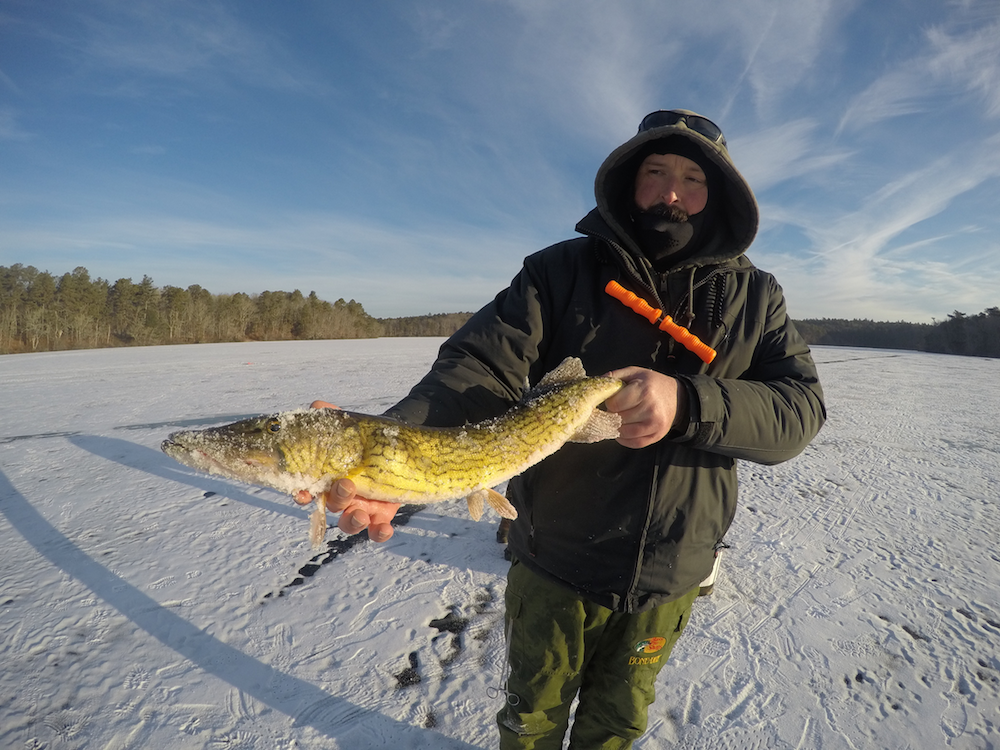
The chain pickerel gets its name from the pattern on its body, which resembles that of a chain-link fence.
Tip #1: Location, Location, Location!
Although it may seem obvious to begin with, it is important to note that just like any species of fish, the chain pickerel cannot be found in every body of freshwater that you come across, but it can be located in a large majority of fishable ponds, lakes and rivers across Massachusetts.
One thing to consider is the forage required to sustain a healthy population of chain pickerel, who are essentially an “apex” predator in their environment.
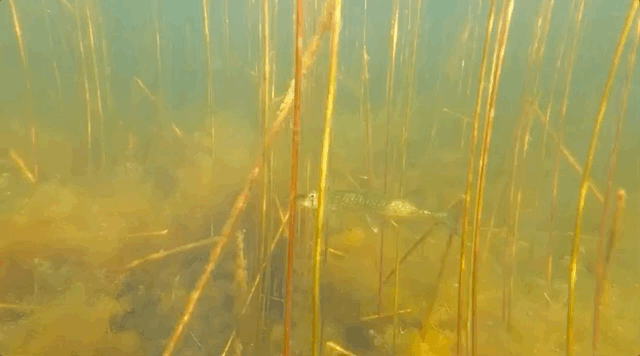
A chain pickerel is in its ideal habitat among the vegetation.
If you are unsure of a new body of water, or have no information on whether or not pickerel have been caught in a particular location, keys to look for are:
For example, a small, mostly landlocked pond containing bluegill, but very little other forage, is an unlikely (but not impossible) bet for finding a healthy population of pickerel.
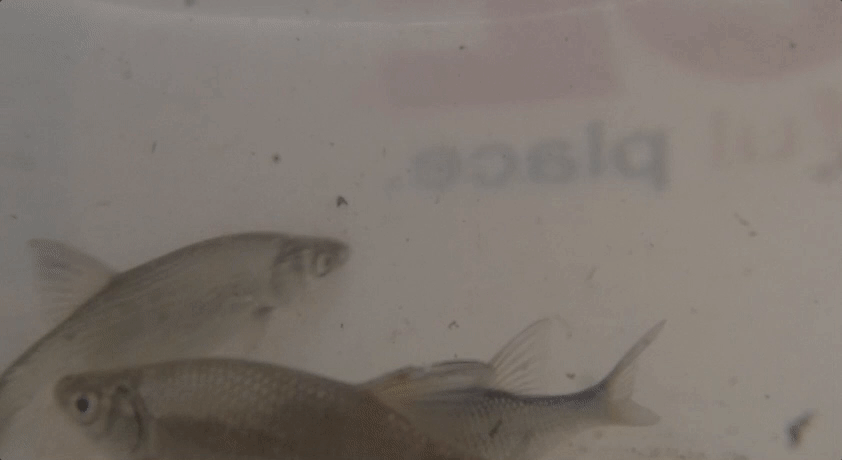
Shiners, perch, and sunfish are all on the menu for chain pickerel.
If by contrast, you come across a pond or stretch of river where you are catching or confirming the existence of perch, golden shiners, and various bluegill/sunfish species all in the same location, there is almost guaranteed to be a pickerel or two stalking along the grass beds and lay-downs by the edge of the water.
Which brings me to my next tip...
Tip #2: Cover is Key
When exclusively targeting pickerel, one of the most important concepts to understand is the method by which they prefer to stalk their prey.
Pickerel are an explosive, yet sneaky predator, and are known to bury themselves in the thickest shoreline cover in order to camouflage themselves until the perfect moment to barrage their prey.
If there is one central concept to remember about these fish, it should be this: chain pickerel LOVE grass. Submerged grass beds, transitions along the edge of a weed-line and mangled wood cover near the shoreline are the pickerel’s ultimate domain.
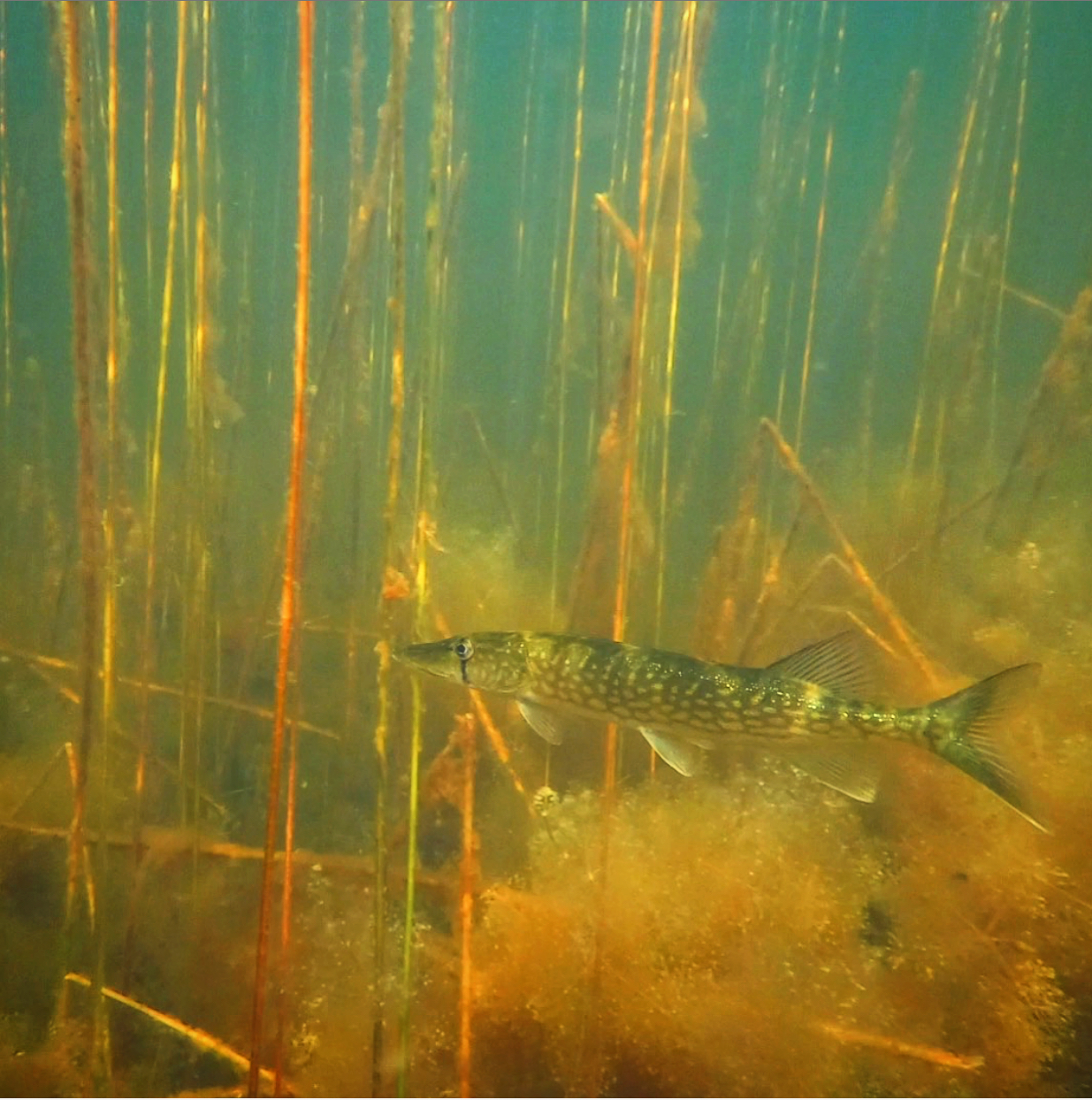
A chain pickerel disguises itself in heavy cover.
Of course, you always stand the chance of pulling a decent largemouth bass out of one of these nooks and crannies, but if you are gunning for your first chain pickerel, head for any grassy patch or transition that you can find, and try casting along the edge of it.
A key factor to consider is that pickerel do not necessarily follow the same exact seasonal patterns as the bass do, and they are slightly more acclimated to cold conditions overall. Because of this, they are more likely to be caught in shallower water from shore during the colder months of the year than almost any other fish in the local ponds and lakes.
This can be motivating for the diehard who is unafraid of the cold. Of course, the chain pickerel is a willing ice fishing participant as well, and they tend to be at their heaviest weight in the winter.
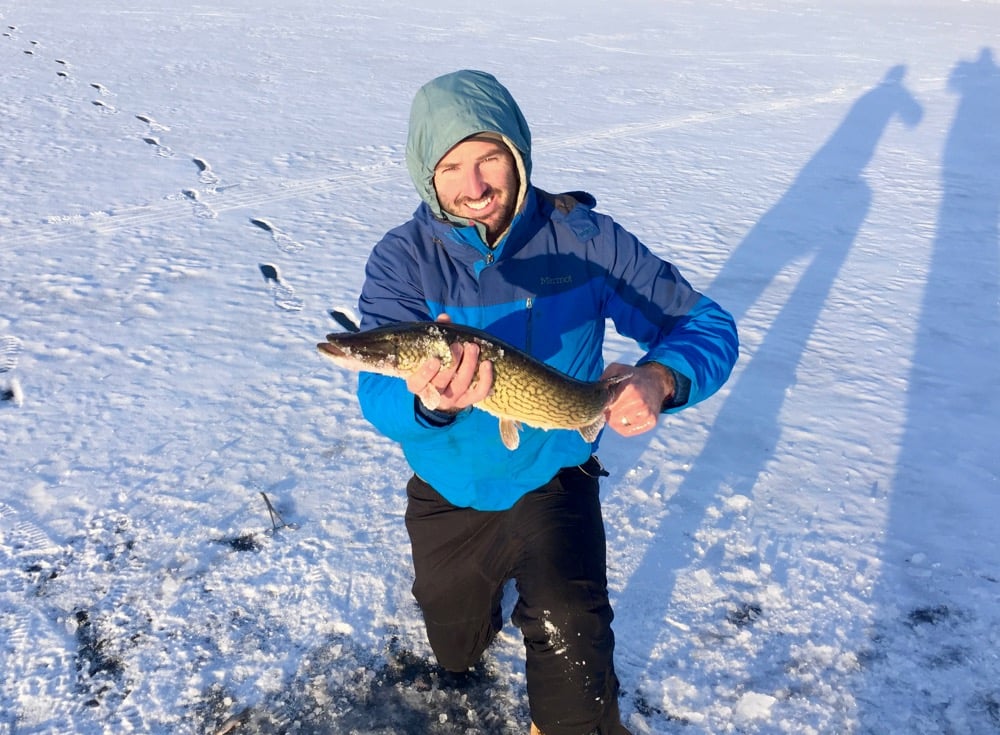
The main point is, chain pickerel are one of the few local fish that will inhabit shallower grass and wood cover for most of the year, unless the pond is frozen, in which case they can still be caught!
Tip #3: Jerkbaits
Here, we can start to get into some of the more specific artificial bait profiles that excel when it comes to targeting chain pickerel. First is the tried and true jerkbait.
Few presentations are more irresistible to a pickerel than a flashy, minnow-shaped bait profile slashing and darting through the water like a struggling shiner.
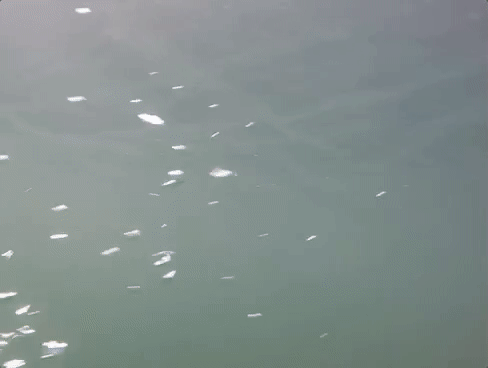
Surefire pickerel magnets in this category include the Rapala Rip-Stop and freshwater X-Rap in the 3.5” or 4 3/4” sizes.
In my experience, yellow perch, as well as emerald/gold shiner patterns vastly outperform other colors and seem to isolate pickerel with fairly remarkable consistency.
Suspending jerkbaits tend to offer the most versatility, as well as the most tempting presentation since pickerel often prefer to strike the lure right after a sudden pause as it floats in place.
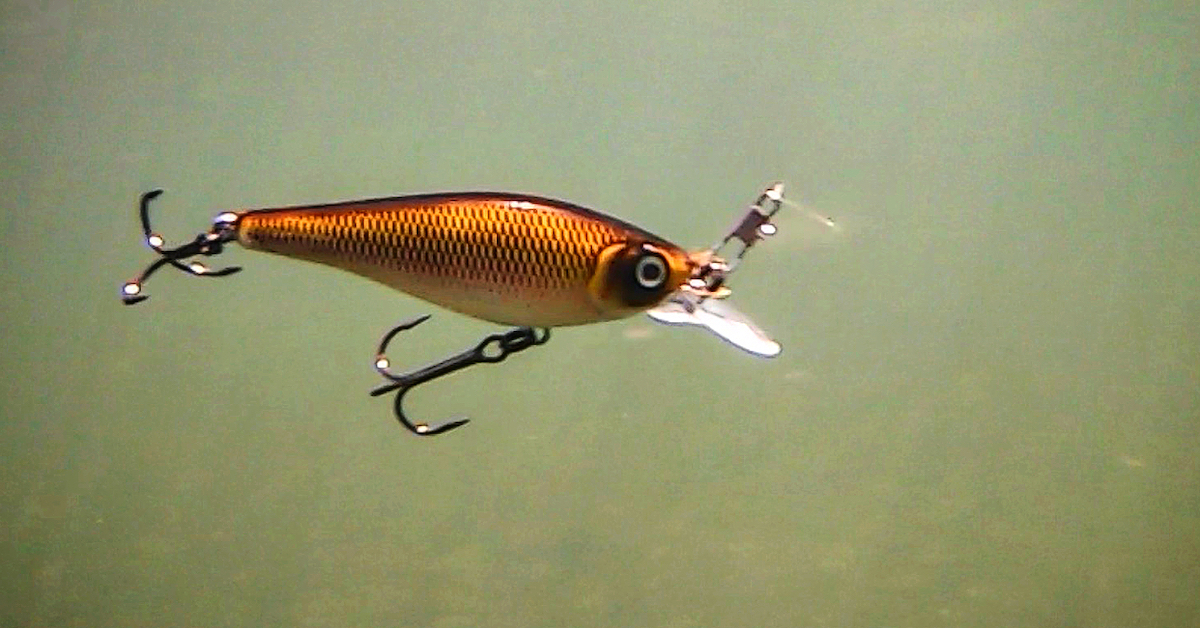
In addition to this, soft plastic jerkbaits like the Zoom Super Fluke work great when the bite is slower, and when rigged weedless, can be pitched right into the grassy cover that pickerel love to hide in.
Tip #4: Spinners, Spoons and Shiny Toys
Other artificial baits that go over notoriously well with the chain pickerel crowd include spinner baits, casting spoons, and almost anything else in your tackle box that puts off a combination of commotion and shine.
Personally, although most of your standard spinnerbaits should work fine, I prefer a small in-line spinner with a single Colorado blade. Booyah spinnerbaits are a popular option as well.
The key is to make sure that you retrieve the bait at least quickly enough to ensure that the spinner is actually rotating correctly, but this should come naturally once you are used to the feeling of the resistance.
Spoons can also be fished effectively for pickerel by allowing the bait to flutter down like a dying shiner, then ripping it off the bottom repeatedly.
Ironically, I use these baits the least when targeting pickerel due to the shallow water and heavy cover that they typically frequent, but if these types of baits are more of your preference, then you can always work around the hang-ups by throwing a weedless spoon.
Tip #5: Retrieval
In what could be described as the "frustrated fisherman’s best-case scenario", the chain pickerel is a classic fool for the reaction strike.
Particularly in the Spring, early Summer, and early Fall seasons, there is no such thing as too fast when it comes to gaining the attention of a hungry pickerel.
Now, you don’t want to always use a fast retrieve when targeting chain pickerel, but if your goal is to isolate these fish, it’s a good idea to start on the faster side, and work your way down.
In fact, if I am totally unsure if a body of water contains these fish, one of the first things I will do is make a cast parallel to the shoreline cover and BURN it back to where I am standing, then immediately stop once I can see the lure.
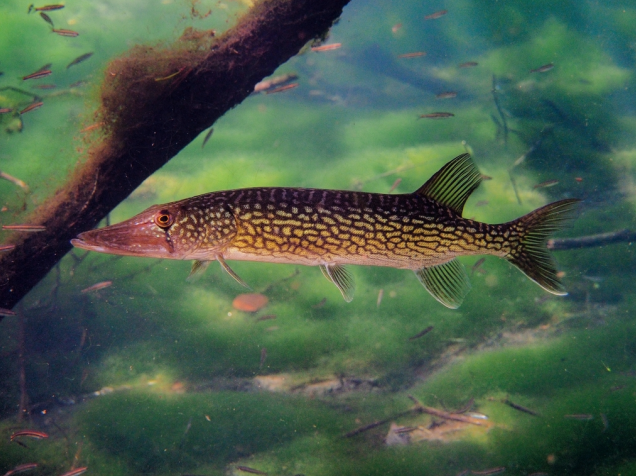
Image courtesy of inaturalist.org
At this point, I will either give it a few light twitches, or just let it suspend for a second. You might be surprised how many times a pickerel will shoot out of the weeds and hammer that bait right in front of you!
I want to be clear that the “madman retrieve” is more of an initial search tactic or fallback rather than the default, but the point is to illustrate how willing a chain pickerel is to chase down a bait in a far more ferocious manner than your average bass.
It's important to keep this mentality at the forefront if you don’t just want to end up with a bunch of largemouth (which wouldn’t be the worst problem to have).
Other than a fast-stop-and-start retrieve, a straight and steady moderate retrieve all the way back to the bank will often get the job done if a pickerel is lurking in the vicinity.
This is especially true with the spinner bait and even sometimes with the jerkbait (since to a pickerel, it might as well be a fleeing minnow). As the weather cools, the old “rip-rip-pause” technique familiar to many striper fisherman becomes extremely effective with the jerkbait. I usually alternate between some variation of 1-5 rips/twitches and then follow with a pause of 1-10 seconds.
As you can see, the angler has a wide range of options that they can experiment with. Ultimately, for the purpose of targeting them exclusively, pickerel are more willing to commit to a fast moving bait than most local freshwater fish.
No matter the speed of the retrieve, the sudden pause seems to be the key factor in eliciting a strike from the pickerel, often at the last second!
Tip #6: Troubleshoot
I think it bears mentioning that if you should experience little success with the above techniques, there are still options. Most obvious, is live bait.
If you are bent on catching chain pickerel and are experiencing difficulty, a bucket full of live shiners will get their attention faster than any man-made lure on the planet, and may technically be the best way to find out if there really are any pickerel in a given pond.

Image courtesy of osgnetworks.tv
Besides the option of live bait, there is one fishing method that has strangely netted me a confounding amount of pickerel that I rarely ever see discussed in regards to this fish...
The wacky worm.
Yup. Not the most efficient bait in terms of durability when it comes to these toothy critters, but alas, for some reason, pickerel REALLY like a wacky worm ripped off the bottom near some vegetation or wood cover, though they may send you back to the bait shop for some new soft plastics.
Another strange pickerel magnet that has the potential to revolutionize your tackle box is the Rebel Cricket Hopper, which is a minuscule topwater crankbait in the shape of a grasshopper.
This lure will catch a great deal more than just pickerel, but pickerel do enjoy hunting larger insects on the surface during the spring and summer, so it’s a great secret weapon if you find yourself struggling.
Tip #7: Rod and Reel Set-Up

Image courtesy of fishingrefined.com
This tip is pretty simple and preference based, but when targeting chain pickerel in specific, it’s important to consider their size and aggression.
Pound for pound, many anglers would agree these fish are one of the strongest fighters in the pond. A large, unexpected 20+ inch pickerel can quickly make a mess of the average ultra-light pond tackle. For this reason, I’d recommend a medium-light or medium rod with a mid range gear-ratio spinning reel just to keep things simple.
There is no need to go overboard on price or specs. I would personally recommend a rod that is not too stiff, but that does have some backbone, especially since pickerel have a tendency to shake their head wildly when hooked.
If the action of the rod is too light, the fish can put unnecessary slack in the line while flailing around, which can spell disaster with pickerel since they stand a high chance of either shaking loose, or getting the line wrapped in their mouth, instantly severing that $10 plug.
Hence my next tip...
Tip #8: Line and Leader
A lot of people might recommend the use of wire leader right off the bat when it comes to these fish, but I do not automatically jump to this option.
The main reason is because I personally believe that the wire leader does affect the presentation negatively to some degree, mainly because quite frankly...the fish can see it in clear water conditions.
Of course, there are different colors that do a better job of disguising the material, and I have certainly still caught plenty of fish using it, but I find that with careful technique, 10-20 pound braid tied to an 10-15 pound fluorocarbon leader (approximately a rod’s length) will lead to a significantly better hook-up ratio in comparison to wire leaders.
In this situation, braided line will provide the ultimate strength and sensitivity compared to monofilament, which I find to be too stretchy when wrangling with these fish.

Wire leader can provide added security when targeting pickerel, but fluorocarbon is usually a viable alternative.
Due to the pickerel’s razor sharp teeth, you have the option to go thicker on your fluorocarbon leader if you feel the need, but it is far more important that you aim keep the line out of the fish’s mouth altogether by avoiding any unnecessary slack while you are fighting it.
Personally, I lose very few pickerel on the standard braid to fluorocarbon set- up, but if you are concerned about losing baits, or you find yourself being broken off with any consistency, I wouldn’t hesitate to switch to the wire.
After setting the hook, it helps to keep the rod upright and steady, and the line taught. This should significantly minimize the chances of the pickerel getting the line caught in its mouth.
It's also especially important to check your leader constantly for the smallest fray, and re-tie whenever necessary.
Tip #9: Handling and Releasing (Bring Pliers!)
At this point, it should be somewhat obvious, but when expecting to encounter chain pickerel, fishing pliers are basically a necessity. Gloves can also be helpful, but they are not required.
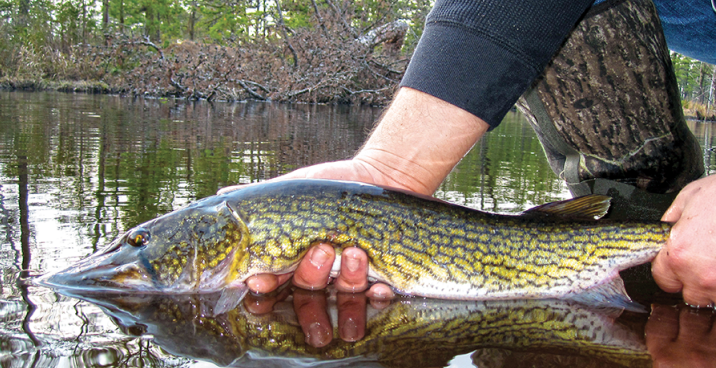
Photo courtesy of arc-anglerfish
There aren't many safe ways to handle a pickerel, so it is essential that you attempt to minimize danger to yourself, as well as to the fish. Though a net would be extremely helpful to have in this scenario, it is not always an available option.
Generally, the best thing to do is to carefully pull the pickerel out of the water. Try to avoid suspending the fish vertically by its jaw, and to do your best to turn the fish horizontal and put one hand under its belly to hold it in place.
These fish despise being handled about as much as they do being hooked, so it will be very difficult to hold the pickerel still, but the best thing to do if it begins to thrash is to try and grab it as gently as possible by the edge of the gill plate while supporting his belly.
This should effectively keep him still for the few seconds it takes to quickly remove the hook with your pliers, then slide him back into the water without touching the ground, as pickerel have a very sensitive layer of slime which can get rubbed off on clothing or on the ground.
The main thing is to make sure that the fish is supported and not thrashing or hanging from his jaw. The more experience you gain with chain pickerel, the more confident you will feel handling and releasing them quickly and safely.
Tip #10: Year-Round Fishing
My final tip is less of a tip and more of a reminder, which is that chain pickerel can be caught all year long in the Northeast!
Long after the vast majority of bass and panfish hole themselves up in the deepest nooks and crannies of the pond for the winter, pickerel are actively on the prowl.

Photo courtesy of bloximages
Similarly to trout, pickerel can be finagled during the winter months of fishing in New England where almost nothing else is biting.
Whether your relationship with this particular fish is one of love, one of hate, or even one of curiosity, I believe that the chain pickerel is an often overlooked species of fish that has the potential to connect the dots and open doors for both new and experienced fisherman alike.
Good luck fishing and tight lines!




Brett, Thanks for writing that article & tips on pickerel. You have me a gift! I haven’t targeted or even caught pickerel in decades. You brought back great memories of pickerel fishing and what a “ tiger” it can be. I’m gearing up for a Pickerel trip as I write this. ?
Hey John! That makes my day to hear that, go get em my friend! It’s about the perfect time of year. Glad you enjoyed the article.
Fantastic tips! These are a favorable target in my family. The intensity of their fight is unparalleled when it comes to freshwater fish on Cape.
If you’re open to a bit of hoofing into the woods, you can find some very large pickerel hiding in the more secluded ponds around Upper Cape.
Locations with sufficient biodiversity and low fishing pressure have been known to produce Pickerel comparable in size to a North Pike in length (albeit far thinner and lighter). Finding these beasts is an absolute joy.
I absolutely agree Marc, and great insights there. It certainly seems true that exploring some of the more overgrown/hidden gems can yield some big surprises when it comes to the pickerel. Just like you pointed out, it can be a shock how big these fish can get after chowing down on massive shiner undisturbed! Glad you enjoyed the article, thank you!
One of the most underrated fish we have. I love chasing pickerel while I wait for the stripers to arrive.
Same Andrew! I always thought of it as mini striper fishing! Other than the added challenge of the teeth, I find that they can sometimes react to baits in a similar way, though more aggressive. Nothing beats catching a schoolie-sized pickerel on the light tackle, especially in the spring like you said!